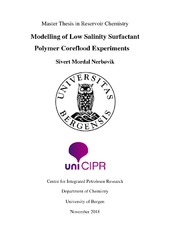| dc.description.abstract | In recent years, there has been a growing interest in the effect of varying brine composition during waterflooding. Several studies on low salinity water injection have been conducted, and the results indicate a potential for increased oil recovery at reduced salinity. Further studies have also shown a significant increase in oil recovery when low salinity injection is combined with surfactant and polymer flooding. This is attributed to the mobilization of oil during low salinity and surfactant floods, and the increased volumetric sweep from polymer injection. In this thesis, modelling of low salinity surfactant polymer (LSSP) coreflood experiments is investigated. The simulations presented in the study was conducted by using the chemical simulator STARS by CMG (Computer Modelling Group). Sensitivity and verification studies were performed in order to confirm STARS’ capabilities of modelling coreflood experiments, and to determine how altering key parameters affected the simulation results. This was followed by a history matching study of a LSSP coreflood experiment conducted by UniResearch CIPR. For the history matching, salinity dependent oil and water relative permeability was used to model low salinity waterflooding. This was based on an assumption that the injection of low salinity brine induced a wettability alteration in the core. Low salinity surfactant injection was modelled by enabling interpolation based on capillary number. The low salinity polymer solution was modelled as a viscosity effect only, due to interpolation problems when adding a third interpolation routine in the model. The experimental oil recovery and differential pressure from the experiment was successfully history matched using the described model. The results thus confirmed that STARS is capable of modelling complex coreflooding processes such as LSSP floods. However, since the model was limited to only two interpolation routines, the physical effects of each injection sequence was not accurately represented. | en_US |
